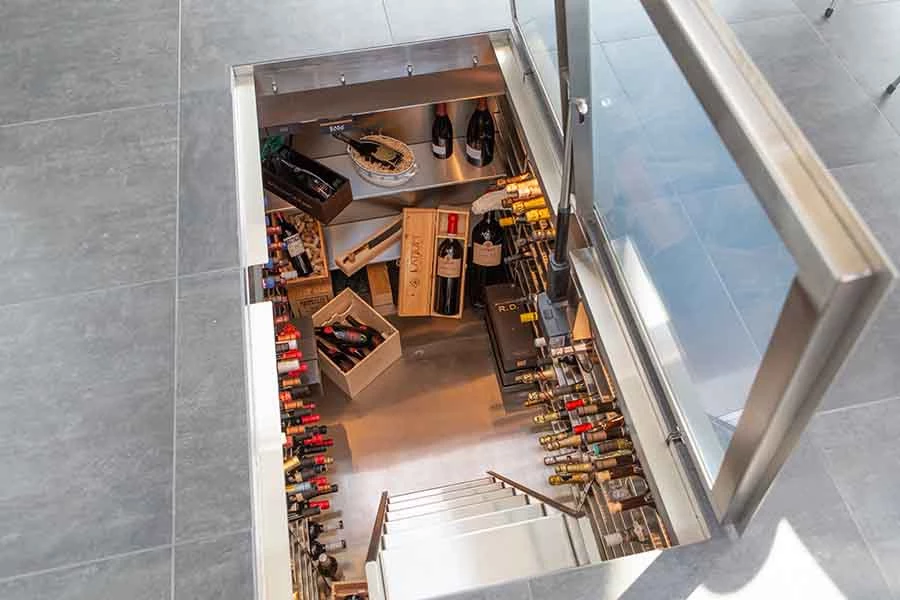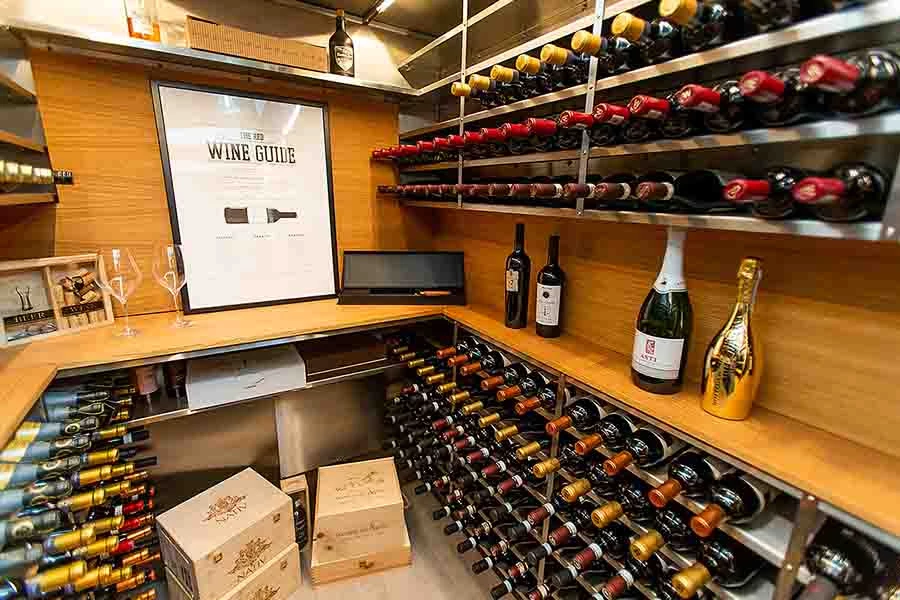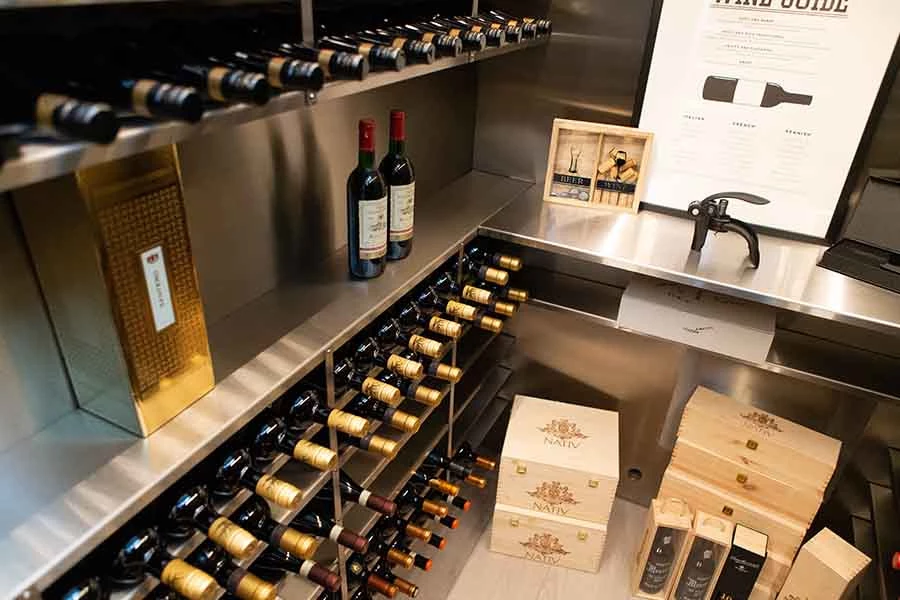Wine Cellar in the basement
Do you have an unused basement and want to create a wine cellar? Utilizing the basement for wine storage offers a space-saving and temperature-stable solution that protects your wine from light and temperature fluctuations. A floor wine cellar adds an exclusive touch to your home.
In this guide, you’ll find everything you need to know about installing a wine cellar in the basement, from planning to maintenance, whether you choose a pre-built module or a custom solution.

What Is a Wine Cellar and Why Should You Consider Having One?
A wine cellar is a dedicated space for storing wine, allowing you to preserve both its quality and taste over time. A floor-embedded wine cellar offers an elegant solution for those who want to integrate wine storage into their home without sacrificing valuable space. It provides a practical and stylish way to store wine, while adding a touch of exclusivity to your home.
Whether you're considering building a wine cellar in an unused room, the basement, converting a crawl space, or creating a custom wine cellar, it's important to have a dedicated space that ensures ideal temperature and humidity levels for your wine. Wine cellar design also plays a key role in organizing bottles efficiently and making the most of your space. There are many options for creating a wine cellar, from pre-made modules to custom solutions tailored to fit your home.
Having a wine cellar not only allows you to store your wine safely and optimally, but also adds a unique element to your home, giving you the perfect space to showcase your collection in style.

Step-by-Step Guide: How to Install a Basement Wine Cellar
Install a basement wine cellar to provide your home with a practical and exclusive wine storage solution. We offer two options: a ready-made wine cellar from Vinorage or a custom solution with a motorized glass door or wine cellar hatch. Below, we explore both options and provide a simple guide to installation, ensuring you can create the perfect space for your wine collection.
Option 1: Ready-Made Wine Cellar from Vinorage
The easiest solution is to install a ready-made wine cellar from Vinorage. This option is ideal for those looking for a quick and stylish way to store wine:
- Preparation: Ensure the basement is dry and measure the available space carefully.
- Installation: Simply follow the supplier's instructions for easy assembly.
- Door/Hatch Installation: Get the vinorage Floor Hatch for easy access.
Option 2: Build Your Own Wine Cellar Room
If you want more control over the design, building your own wine cellar room in the basement gives you full customization options. Choose materials like concrete or wood and tailor the space to your specific needs:
- Preparation: Inspect the basement and measure the space carefully to ensure it fits your plans.
- Building: Use durable materials that can withstand moisture and temperature fluctuations.
- Ventilation and Climate Control: Ensure the room is equipped for optimal temperature and humidity levels to preserve your wine.
- Motorized Glass Door Installation: For a sleek, modern look, choose a motorized wine cellar hatch.
Looking for more ideas for a custom wine cellar? Explore our detailed guide for more inspiration! Whatever option you choose, you’ll end up with a practical and aesthetically pleasing wine cellar that’s perfect for storing your wine in ideal conditions.
How to Plan a Wine Cellar in a Basement?
Planning is crucial for a successful floor-embedded wine cellar, especially in a basement. Before starting, you should carefully consider several factors such as space, temperature, and humidity to ensure you're creating the optimal environment for your wine.
Plan a wine cellar in the basement by checking the basement's height to ensure there is enough room for the wine cellar. If space is limited, you may want to consider alternative solutions like a wine cellar under the stairs or a custom DIY wine cellar that can be tailored to fit your needs.
The temperature in the basement should be stable, ideally between 12-16°C, depending on the type of wine, as this range is perfect for wine storage. If the temperature fluctuates too much, it may be worth installing a temperature control system to ensure your wine is kept under the best conditions. Humidity is also important; it should be maintained at a level that protects the wine, and a good ventilation system can help maintain this balance.
Before you begin building, it's important to check whether you need a building permit. Make sure all local requirements and regulations are followed by contacting the authorities for information on the necessary permits.
Alternative Wine Storage Solutions
While a wine cellar in the basement can offer excellent storage conditions, there are several alternative solutions that may be more suitable depending on your space and needs.
Wine Fridge
Wine cabinets provide a flexible and space-saving solution. These units come in various sizes and can easily be placed in a room without requiring extensive construction work. They offer stable temperature control and are ideal for both small and large wine collections.
Elevation Wine Cellars
An elevated wine cellar is positioned at a raised level within an existing room. This provides both aesthetic appeal and practical access to your wine, while also saving space. Such a solution can also be an elegant addition to your home.
Choose the Best Solution
Whether you choose a wine cabinet or an elevated wine cellar, it’s important to consider factors such as space, design, and budget. Both options offer optimal wine storage conditions, but in different ways.
Advantages and Disadvantages of a Wine Cellar in the Basement
A wine cellar in the basement is a practical and stylish solution for home wine storage. It utilizes unused space and offers several benefits, but there are also some drawbacks to consider before starting the project.
Advantages of a Wine Cellar in the Basement
- Space-saving: Makes use of the space under the house, providing discreet wine storage, ideal for small homes.
- Optimal temperature: The basement offers stable climate conditions, perfect for preserving wine.
- Protection from light: Keeps wine shielded from harmful UV rays and light.
- Aesthetic solution: Creates a luxurious and sleek room for wine storage.
- Discreet and elegant: A wine cellar that doesn't take up much space and can be equipped with a motorized wine cellar floor hatch.
Disadvantages of a Wine Cellar in the Basement
- Requires adjustments: Installation can be time-consuming and may incur additional costs.
- Humidity: Basements can have high humidity, requiring good ventilation to protect the wine.
- Limited space: The basement may be small with low ceilings, requiring alternative solutions in some cases.
A wine cellar in the basement offers many benefits, especially in terms of space-saving and protecting your wine. With the right adjustments, it can be a practical and stylish solution.

Wine Cellar in the Basement: A Summary
A wine cellar in the basement is a great solution if you have the space, offering stable temperatures and protection from light. When installing, consider ceiling height, humidity, ventilation, and the floor’s load-bearing capacity. You can opt for a ready-made solution like Vinorage or customize it yourself.
Benefits include space-saving and a stable climate, while the downsides involve costs and monitoring humidity and temperature. If this doesn’t work, wine fridges or other solutions might be alternatives.
If you have questions, contact our customer service for help.
